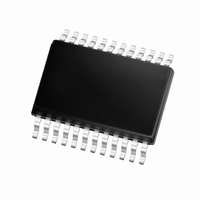MCP3909-I/SS Microchip Technology, MCP3909-I/SS Datasheet - Page 87

MCP3909-I/SS
Manufacturer Part Number
MCP3909-I/SS
Description
IC POWER METERING-1 PHASE 24SSOP
Manufacturer
Microchip Technology
Datasheets
1.MCP3909T-ISS.pdf
(44 pages)
2.MCP3909T-ISS.pdf
(104 pages)
3.MCP3909-ISS.pdf
(40 pages)
Specifications of MCP3909-I/SS
Package / Case
24-SSOP (0.200", 5.30mm Width)
Input Impedance
390 KOhm
Measurement Error
0.1%
Voltage - I/o High
2.4V
Voltage - I/o Low
0.85V
Current - Supply
2.3mA
Voltage - Supply
4.5 V ~ 5.5 V
Operating Temperature
-40°C ~ 85°C
Mounting Type
Surface Mount
Meter Type
Single Phase
Operating Temperature Range
- 40 C to + 85 C
Mounting Style
SMD/SMT
Supply Voltage Range
4.5V To 5.5V
Digital Ic Case Style
SSOP
No. Of Pins
24
Interface Type
Serial, SPI
Supply Voltage Max
5.5V
Rohs Compliant
Yes
Lead Free Status / RoHS Status
Lead free / RoHS Compliant
For Use With
MCP3909EV-MCU16 - EVALUATION BOARD FOR MCP3909MCP3909RD-3PH1 - REF DESIGN MCP3909 3PH ENGY MTR
Lead Free Status / Rohs Status
Lead free / RoHS Compliant
Available stocks
Company
Part Number
Manufacturer
Quantity
Price
Part Number:
MCP3909-I/SS
Manufacturer:
MICROCHIP/微芯
Quantity:
20 000
C.5
© 2009 Microchip Technology Inc.
MEASURING FREQUENCY
There are many ways to measure frequency, with the most common being counting the
signal cycle. In this method, a counter increments each time a zero-crossing is
detected. Based on the counts, the width of a cycle can be measured. If the zero-cross-
ing is accurate and the counter precision is high enough, cycle counting can be a
simple and practical method. But if the input signal has large harmonic components,
causing distortion around zero-crossing, then this approach may produce large errors.
Another method is to analyze and process the sampled data and calculate the frequen-
cies. Analysis may be carried out in time domain, such as digital differential ND and
interpolation method; or may be carried out in frequency domain after DFT transforma-
tion, such as gravity center method, spectrum zoom method and phase difference
method, among which the phase difference method is the most common one. It is not
sensitive to signal distortion around zero-crossing points.
The basic idea of the phase difference method is: if the rough range of to-be-measured
signal frequency is known, then we may assume a frequency that is close to the actual
frequency and then acquire an array of samples based on the assumed frequency. In
the sampled data, the phase of the 1st cycle and the subsequent N-th cycle are meau-
red and their difference may be calculated. Then the phase difference may be used to
calculate the difference between the actual freqency and the assumed frequence, thus
figuring out the actual frequency.
If the frequency f
Δf << f, then from Equation C-27, the fundamental signal can be expressed as:
EQUATION C-45:
If:
EQUATION C-46:
EQUATION C-47:
EQUATION C-48:
0
to be measured is known to be a definite value f, i.e., f
U
1
t ( )
u
u
a
b
=
=
=
=
=
u
-- -
T
2
2
-- -
T
c1
-- -
T
2
2
-- -
T
⋅
⋅
⋅
sin
⋅
T
∫
0
T
∫
0
T
∫
0
T
∫
0
U
U
u
u
(
c1
1
c1
1
ω
Power Calculation Theory
t ( )
t ( )
sin
sin
⋅
t
cos
sin
+
(
(
2
T
2
(
ϕ
(
π
π
ω
ω
u1
=
f
f
0
t
0
t
t
)
t
)
)
1
-- -
t d
f
t d
+
+
=
ϕ
ϕ
u
u1
u1
c1
)
)
cos
sin
sin
(
(
(
2
2
2
π
π
π
f
ft
ft
0
)
t
)
t d
t d
+
ϕ
u1
)
DS51723A-page 87
0
= f + Δf,













